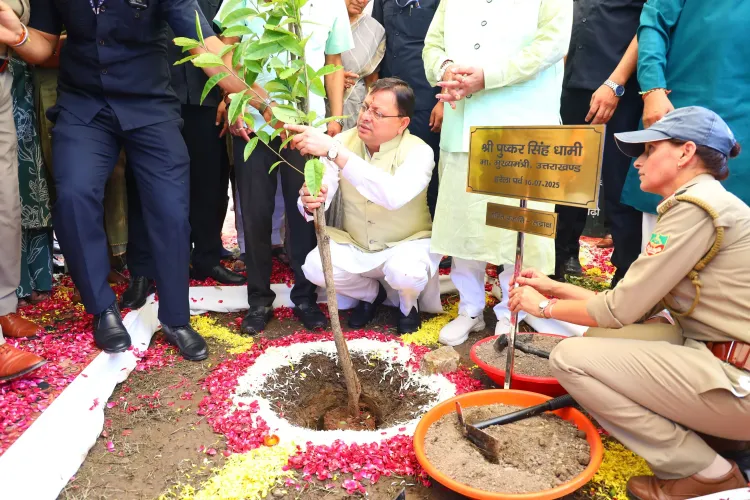How Did Uttarakhand Transform Harela Festival into an Environmental Movement?

Synopsis
Key Takeaways
- Over 8.13 lakh saplings planted across Uttarakhand.
- Chief Minister Dhami emphasized the campaign as a people's movement.
- Significant contributions from all districts, showcasing widespread community involvement.
- The event represents a blend of cultural heritage and environmental awareness.
- Uttarakhand is committed to balancing development with environmental protection.
Dehradun, July 16 (NationPress) Uttarakhand experienced an extraordinary change as the Harela festival transitioned from a cherished cultural event into a widespread environmental initiative on Wednesday.
With an impressive 8.13 lakh saplings planted across all 13 districts, this year marked the state's most extensive tree plantation campaign during any festival, transforming the celebration into a symbol of ecological renewal and community involvement.
Motivated by Prime Minister Narendra Modi's appeal for environmental responsibility, Chief Minister Pushkar Singh Dhami broadened the “Ek Ped Maa Ke Naam” campaign into a statewide effort under the theme “Celebrate Harela, Repay the Debt of Mother Earth.”
The Chief Minister kicked off the initiative by planting a sapling in Dehradun, highlighting that this campaign is not just a government initiative but a people's movement based on collective accountability.
According to state government data, tree planting efforts during the Harela festival saw enthusiastic participation from all districts in Uttarakhand.
Data revealed that Champawat spearheaded the initiative with over 1.24 lakh saplings planted, followed closely by Udham Singh Nagar with approximately 93,800 and Uttarkashi with over 89,000. Significant contributions also came from Pithoragarh, Chamoli, and Garhwal, each exceeding 60,000 plantings.
Even smaller districts like Bageshwar, Rudraprayag, and Nainital demonstrated strong involvement, adding tens of thousands of trees to the overall total.
With more than 8.13 lakh plants now rooted across the state as of July 16, the data not only illustrates the scope of the campaign but also the decentralization of its impact—every district contributing to painting Uttarakhand green.
From remote villages to bustling urban centers, thousands of plantation events unfolded simultaneously, engaging local governments, forest officials, school students, Anganwadi workers, women's groups, and youth volunteers.
This collective effort enhanced Uttarakhand's reputation as a land deeply intertwined with nature and dedicated to sustainable development.
Traditionally, Harela is celebrated to signal the arrival of the monsoon and the agricultural cycle, reflecting the cultural essence of Uttarakhand. However, this year, the festival embraced a new dimension—one that marries heritage with environmental awareness.
The saplings planted symbolize more than just trees; they represent hope, resilience, and the promise of a greener future.
Chief Minister Dhami emphasized that Uttarakhand is not merely a Himalayan state but a shining example of civic consciousness and ecological responsibility.
He reaffirmed the government's commitment to harmonizing development with environmental conservation, asserting that safeguarding forests, water sources, and land is fundamental to the state's policy framework.
As these saplings take root, they signify more than just greenery—they embody a collective awakening. The Harela festival of 2025 will be remembered not just for its traditions and festivities but for uniting an entire state in the pursuit of a greener, more sustainable future.









